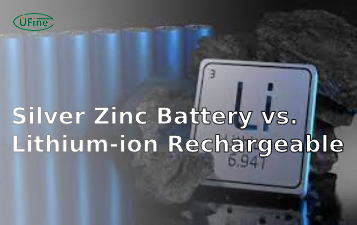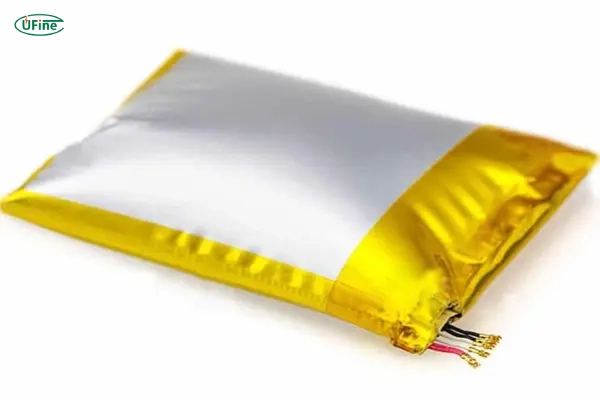
Lithium battery swelling is commonly known as bulging. It often results from internal chemical reactions, leading to gas buildup, which causes the battery to expand and distort.
The swelling process can compromise the battery’s integrity, potentially leading to leaks, fires, or even explosions. Safely disposing of these batteries is crucial to prevent environmental harm and personal injury.
Part 1. Why do lithium batteries swell?
Swollen lithium-ion or lithium-polymer (LiPo) batteries typically swell due to internal chemical reactions. This process, known as battery bulging, often occurs due to overcharging, physical damage, or improper handling. Environmental factors like moisture and high temperatures also contribute to swelling. Understanding these causes helps in preventing risks like leaks, fires, and explosions, ensuring safe disposal of swollen lithium batteries.
- Poor packaging: Air moisture enters the inside of the battery cell during the production process, causing the electrolyte to react and create gas.
- The water content of the electric core exceeds the standard: If the water content exceeds the standard, the electrolyte will react and produce gas.
- Corrosion: Corrosion of the lithium polymer cell, where the aluminum layer is consumed, can result in a loss of the water barrier, causing swelling.
- Surface breakage: Damage from external forces or punctures leads to water entering the battery core. Lithium’s highly reactive nature poses a high risk when exposed to air, causing a violent oxidation reaction with oxygen.
- Impact: Aluminum material is easily deformed; larger cores are more likely to create air pockets and damage.
- Short circuit: Positive and negative contacts can short-circuit, leading to battery swelling or even smoke.
- Internal short circuit: Shrinkage, curling, or breakage of the battery isolation film can cause internal disconnections and swelling.
- Over-charging/over-discharging: Overcharging or over-discharging, coupled with protection board abnormalities, can result in significant bulging of battery cells.
Part 2. How do you dispose of lipo batteries?
Isolation and safety measures
When handling swollen lithium polymer (LiPo) batteries, isolation and safety measures are paramount. These batteries can pose severe risks due to potential leaks, fires, or explosions.
Isolation
Begin by isolating the swollen LiPo battery in a safe, controlled environment to minimize the risk of accidents. Always wear appropriate protective gear, such as gloves and eye protection, to prevent direct contact with any leaked chemicals or substances.
Safety measures
Ensure the area is well-ventilated and free from any flammable materials or sources of ignition. Any handling of swollen batteries should be done cautiously and with great care.
Transportation and storage
Transporting a swollen LiPo battery demands extreme caution to avoid accidents during transit. Use a fireproof container that can contain potential fires or leaks from the damaged battery. Store the container in a cool, dry place away from direct sunlight and sources of heat.
Handling precautions
Avoid storing multiple swollen batteries together, as this could increase the risk of accidents. Always handle and transport such batteries individually.
Recycling programs
Utilizing dedicated battery recycling programs or facilities that accept damaged lithium batteries is a safe and responsible disposal method. Many recycling centers have the expertise and resources to handle damaged batteries safely and to prevent environmental contamination.
Collection centers
Locate recycling centers that specifically cater to damaged or swollen LiPo batteries. These centers often have specialized equipment and procedures to handle and dispose of damaged batteries in an environmentally friendly manner.
Part 3. Lipo battery disposal DIY guidelines
Puncturing and discharging
Disposing of swollen lithium polymer (LiPo) batteries can be a challenging task. However, if you’re knowledgeable and cautious, there are DIY methods to handle this safely.
Puncturing
Puncturing the battery is a risky method but can be employed by knowledgeable individuals. Use a non-conductive tool to puncture the battery in a controlled environment with proper safety gear. This should be done in an area that’s fireproof and isolated from combustible materials.
Discharging
After puncturing, discharge the battery slowly in a safe manner to reduce the risk of ignition or combustion. A bucket of saltwater or sand can be used to immerse the battery to dampen any potential fire hazards.
Neutralizing chemicals
When dealing with damaged LiPo batteries, there might be leaked or exposed chemicals. Neutralize any spilled electrolyte by carefully applying baking soda or another alkaline substance. This can help neutralize the acidic properties of the electrolyte, reducing its potential harm.
Precautions
Always handle any spilled chemicals with extreme caution. Wear appropriate protective gear such as gloves and goggles to prevent direct contact.
Container disposal
Once the battery is discharged and neutralized, place it in a fireproof container. A metal container with a tight-fitting lid can help contain any potential fires or leaks that might occur during storage or transportation.
Transportation
Ensure the container is stored in a cool, dry place away from direct sunlight or heat sources. If possible, transport the container to a hazardous waste disposal facility that can handle damaged or hazardous batteries.
Part 4. Conclusion
Safe disposal of swollen LiPo batteries requires a careful approach that prioritizes safety and environmental responsibility. Isolation, safe handling, proper transportation, and utilizing recycling programs are essential steps to prevent accidents, environmental contamination, and personal harm. Always follow recommended guidelines and seek professional assistance if uncertain about handling damaged batteries.
Battery Safety Essentials
Part 5. FAQs
-
What to do with a swollen lithium battery?
Safely handle swollen lithium batteries by avoiding puncturing or mishandling them. Store them in a fireproof container and seek recycling options or professional disposal services. -
How do you safely discharge a LiPo battery?
Safely discharge a LiPo battery by using a specific discharge device or discharging it through a low-power device until it reaches a safe voltage level, following proper safety precautions. -
What happens if you puncture a lithium polymer battery?
Puncturing a lithium polymer battery can cause it to short-circuit, leading to thermal runaway, overheating, or even fire. Immediately evacuate the area and seek professional help. -
How do you dispose of a ruptured lithium battery?
If a lithium battery is ruptured or damaged, handle it with extreme caution using gloves and place it in a fireproof container. Then, contact local waste disposal or recycling facilities for proper handling. -
What should I do with a swollen lithium-ion battery?
If you have a swollen lithium-ion battery, handle it with extreme care. Isolate it in a safe, fireproof container, and avoid puncturing or mishandling. Always contact local recycling centers or disposal programs for safe disposal. -
How do you safely dispose of a damaged LiPo battery?
Damaged LiPo batteries can be hazardous if not disposed of properly. Store them in a fireproof container and transport them to a recycling facility equipped to handle damaged batteries. Ensure you wear safety gear to avoid exposure to harmful chemicals. -
Can I dispose of a swollen lithium battery at home?
While it’s safest to use professional recycling services, some individuals opt for DIY methods. However, always take the necessary precautions to prevent fires or exposure to harmful substances. -
Is it bad to leave a LiPo fully charged?
Leaving a LiPo battery fully charged for extended periods can increase degradation and reduce its lifespan. Storing LiPo batteries at around 50% charge is recommended for long-term storage to maintain their health.
Related Tags:
More Articles

What is the Difference Between Silver Zinc Battery vs. Lithium-ion Rechargeable?
Compare silver zinc and lithium-ion rechargeable batteries: energy density, cycle life, safety, cost, and uses in drones, medical devices, EVs, and electronics.
What are Watts and Watt Hours in Battery?
Understand watt vs watt-hour in batteries: key differences, how to calculate capacity, and why they matter. Includes free comparison table.
Best 10 Blood Pressure Monitor Battery Review: Finding the Most Reliable
Are you looking for a reliable Blood Pressure Monitor battery? Here is a complete guide with the top 10 best blood pressure monitor batteries.
Bluetooth Headphone Battery Guide: All You Need to Know
Maximize headphone battery life with expert tips! Learn how to charge, check, troubleshoot, and choose the best bluetooth headphone battery in 2025.
LiFePO4 Battery VS. Lithium-ion Polymer Battery: Which One Is Best?
Comprehensive comparison of LiFePO4 vs Lithium Ion Polymer batteries: energy density, safety, lifespan, cost. Find out which battery suits your needs in 2025.



